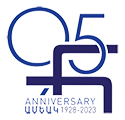The Armenian Educational and Publishing Pan-national (Hamazkayin) Association was founded in Lebanon in 1930. Until 1970, chapter committees in various regions conducted Hamazkayin’s diverse activities. Art events, theater shows, lectures, discussions and debates, seminars, and social activities were among these many activities.
In 1975, the first-ever Regional Committee of Hamazkayin was formed in Lebanon. In its early days, it functioned via its councils. The mission of the music, theater, and literature councils was to develop projects and present them to the Regional Committee. The latter would coordinate the various projects as future activities and would produce them in cooperation with the chapter committees.
Soon, due to the growing range of activities, it was apparent that Hamazkayin needed to specialize its focus. Young professionals joined the councils. They had both the knowledge and desire to produce activities in the various spheres of culture. With the utmost consideration and professionalism, the literature, theater, dance, and music units were formed. Soon they succeeded in organizing events that resonated with the Lebanese community.
The chapters continued to function alongside the units. Starting in 1986, the chapters were named after Armenian cultural figures. The Beirut chapter (founded in 1931) was named Gomidas, the Bourj Hamoud chapter (founded in 1952) was called Simon Vratsian, the Ashrafiye chapter (founded in 1953) was named Roupen Zartarian, the Antelias chapter (founded in 1970) became Nigol Aghpalian, the Ainjar chapter (founded in 1972) was named Barouir Sevag, and the Nahr El Mote chapter (founded in 1986) was called Hamo Ohanjanian.
In the 1980s, Hamazkayin’s activities in Lebanon were so widespread that a center became necessary. Choirs, theater companies, and music classes were increasing in number and activities. Building the Cultural Center of the Regional Committee was a major achievement. Its opening ceremony in 1988 was presided over by Karekin II, the Catholicos of the House of Cilicia. The center was named the Levon Shant Cultural Center. However, soon even that space could not accommodate all of Hamazkayin’s activities. In 2005, the Jirayr Khachadourian Center at the Aghpalian-HMEM cultural and sports complex in Antelias opened. The Hamazkayin Art schools operate at both centers.
The Paresegh Ganachian Music College was founded in 1983. The music college has around 200 students. The first director of the college was Vache Barsoumian. Sona Kupelian, Setrag Setragian, Yervant Yerganian, have served as principals. Today, Armen Kecheg serves in that position. Specialized teachers instruct students in piano, violin, guitar, and many other instruments. The college has annual student concerts. It participates in various music contests. The music college also has a suitable music library. A special agreement with the Gomidas State Conservatory in Yerevan guarantees graduates a chane to complete their education there.
The Toros Roslin Art School was founded in 1981. It has around 60 students. The students take regular painting courses, and present their works in student and graduate exhibitions. They also take part in inter-school contests and exhibitions. The school has a well-developed curriculum and teachers. The teachers include Lebanese-Armenian artists and artists from Armenia. The administrator of Toros Roslin Art School is Janet Yapoujian.
The Kayaneh Dance School was founded in 1989. It has around 270 students. At various class levels, the school teaches various branches of dance. It has annual concerts and tours. For many years, artist Felix Haroutiounyan from Armenia was the chief dance instructor and choreographer. At present, artist Andranik Grigoryan from Armenia serves in that role.
Gargach children’s, teenager’s and youth choirs were founded in 1997. The choir is divided according to the ages of its members, who take vocal lessons and present annual concerts. The choirs have also conducted their own concert tours. The choirs regularly perform premieres of new songs composed especially for them by composers from Armenia. The choirs are conducted and directed by Zakar Keshishian. The total number of the members is around 150.
Arek Children’s and Youth Theater School was founded in 1999. The first director of the theater company was stage director Vigen Stepanyan from Armenia and, later, Davit Hakobyan from Armenia. Currently, artist Hasmig Bertizlian directs the school.
The Knar Dance Troupe was founded in 1956, due to the efforts of Dr. Vartkes and Mrs. Eglantine Aprahamian. At present, the dance troupe has around 40 members. For some time, Carina Alexanderian was the dance instructor. At present, Phelix Harutiunyan is the instructor and the chief choreographer.
The Kasbar Ipegian Theater Company, previously the Theater Association, was founded in 1941, by Kasbar Ipegian. Kasbar Ipegian, Georges Sarkissian, Papken Papazian, Varoujan Khedeshian, and Davit Hakobyan have served as directors of the Theater Company. At present, a youth group has been created to complement the Theater Company. It is directed by young stage director Souren Khedeshian.
The Kousan Choir was founded in 1956. At first, it was known by the name of its founder, Parsegh Ganachian. Haroutioun Topigian and Yervant Yerganian, have also conducted the choir. At present, Barkev Taslakian conducts the choir. It has around 60 members.
The Regional Committee has subcommittees, which assist in the organization of various events. The art schools have their boards of trustees. The Gargach choirs, Kasbar Ipegian Theater Company, and Knar Dance Troupe have their committees, which assist with organizational matters and assist in producing annual events.
To foster the bonds between Armenia and diaspora, the Regional Committee of Hamazkayin in Lebanon frequently presents to the Lebanese-Armenian audience events featuring artists and artistic groups from Armenia. These events regularly receive high praise.
With its consistent efforts and achievements, Hamazkayin has a unique place in the cultural life of the Lebanese-Armenian community.


